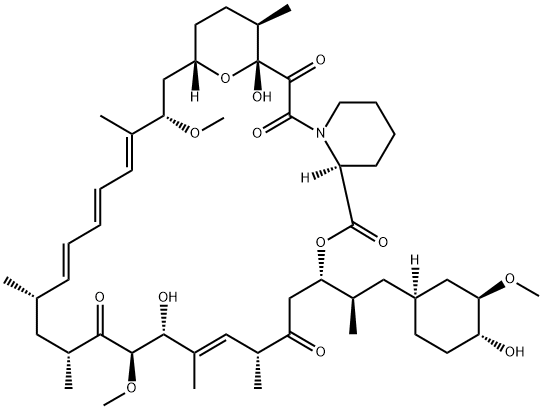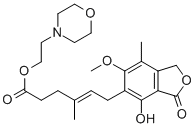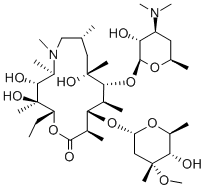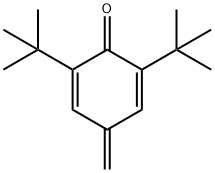Rapamycin , ≥98%(HPLC) , 53123-88-9
Synonym(s):
Rapamycin;Sirolimus;23,27-Epoxy-3H-pyrido[2,1-c][1,4]oxaazacyclohentriacontine;23,27-Epoxy-3H-pyrido[2,1-c][1,4]oxaazacyclohentriacontine solution;mTOR Inhibitor I
CAS NO.:53123-88-9
Empirical Formula: C51H79NO13
Molecular Weight: 914.19
MDL number: MFCD00867594
EINECS: 610-965-5
| Pack Size | Price | Stock | Quantity |
| 10MG | RMB31.20 | In Stock |
|
| 25mg | RMB63.20 | In Stock |
|
| 50MG | RMB120.80 | In Stock |
|
| 250MG | RMB302.40 | In Stock |
|
| 1g | RMB804.00 | In Stock |
|
| others | Enquire |
PRODUCT Properties
| Melting point: | 183-185°C |
| alpha | D25 -58.2° (methanol) |
| Boiling point: | 799.83°C (rough estimate) |
| Density | 1.0352 (rough estimate) |
| vapor pressure | 0.56 hPa ( 20 °C) |
| refractive index | 1.5280 (estimate) |
| Flash point: | 87 °C |
| storage temp. | -20°C |
| solubility | ethanol: soluble2MM |
| pka | 10.40±0.70(Predicted) |
| form | solution |
| color | colorless to yellow |
| Water Solubility | Soluble in DMSO at 50mg/ml or methanol at 25mg/mlSoluble in alcohol, dimethyl sulfoxide and dimethyl formamide. Insoluble in water. |
| Sensitive | Moisture Sensitive/Light Sensitive/Hygroscopic |
| Merck | 14,8114 |
| Stability: | Stable for 2 years? from date of purchase as supplied.? Solutions in DMSO or ethanol may be stored at -20°C for up to 2 months. |
| CAS DataBase Reference | 53123-88-9(CAS DataBase Reference) |
Description and Uses
Rapamycin is a member of the macrolide immunosuppressant family and a FRAP inhibitor. Rapamycin exhibits binding and inhibitory actions to the FK506 binding protein (FKBP5) proline rotamase via simultaneous binding by FKBP12 and FRAP. FRAP (RAFT1) proteins exhibit homology to PI 4- and PI 3-kinases, which have PI 4-kinase and autophosphorylating activities. The rapamycin/FKBP complex does not inhibit the FRAP PI 4-kinase activity, but does inhibit FRAP autophosphorylation. Rapamycin is unique in its ability to inhibit lymphokine induced cell proliferation at the G1 and S phase as well as an irreversible cellular arrest at the G1 phase in S. cerevisiae cells. Rapamycin also exhibits selective signal blocking leading to the activation of p70/85 S6 kinase, which is potentially due to the inhibition of FRAP autophosphorylation or protein kinase activity. Rapamycin also exhibits Angiogenesis inhibition, possibly through the inhibition of the Akt pathway. Rapamycin is an inhibitor of mTOR. Rapamycin is also known as Rapamune, 23,27-Epoxy-3H-pyrido[2,1-c] oxaazacyclohentriacontine, AY 22989, and mTOR Inhibitor I.
Rapamycin is a triene macrolide discovered in 1995 as a metabolite of Streptomyces hygroscopicus found in a soil obtained on Rapi Nui (Easter Island). Rapamycin displayed potent and selective antifungal activity, notably against Candida albicans. Interest in the metabolite waned until the structural relationship to the potent immunosuppressant fujimycin (Antibiotic FK506) was recognised in the mid-1980s. This recognition led to the re-discovery of rapamycin as a highly selective antitumour and immunosuppressant. Rapamycin inhibits the activity of the protein, mTOR (mammalian target of rapamycin) which functions in a signalling pathway to promote tumour growth. Rapamycin binds to a receptor protein (FKBP12). The rapamycin/FKB12 complex then binds to mTOR and prevents interaction of mTOR with target proteins in this signalling pathway.
Safety
| Symbol(GHS) |  GHS08 |
| Signal word | Warning |
| Hazard statements | H351-H361fd |
| Precautionary statements | P201-P202-P280-P308+P313-P405-P501 |
| Hazard Codes | Xi,Xn,F |
| Risk Statements | 36/38-36-20/21/22-11 |
| Safety Statements | 22-24/25-37/39-26-36/37-16 |
| RIDADR | UN 1648 3 / PGII |
| WGK Germany | 2 |
| RTECS | VE6250000 |
| Autoignition Temperature | 301 °C |
| HS Code | 29349990 |
| Hazardous Substances Data | 53123-88-9(Hazardous Substances Data) |
| Toxicity | LD50 in mice (mg/kg): 600 i.p.; >2,500 orally (Vézina) |






